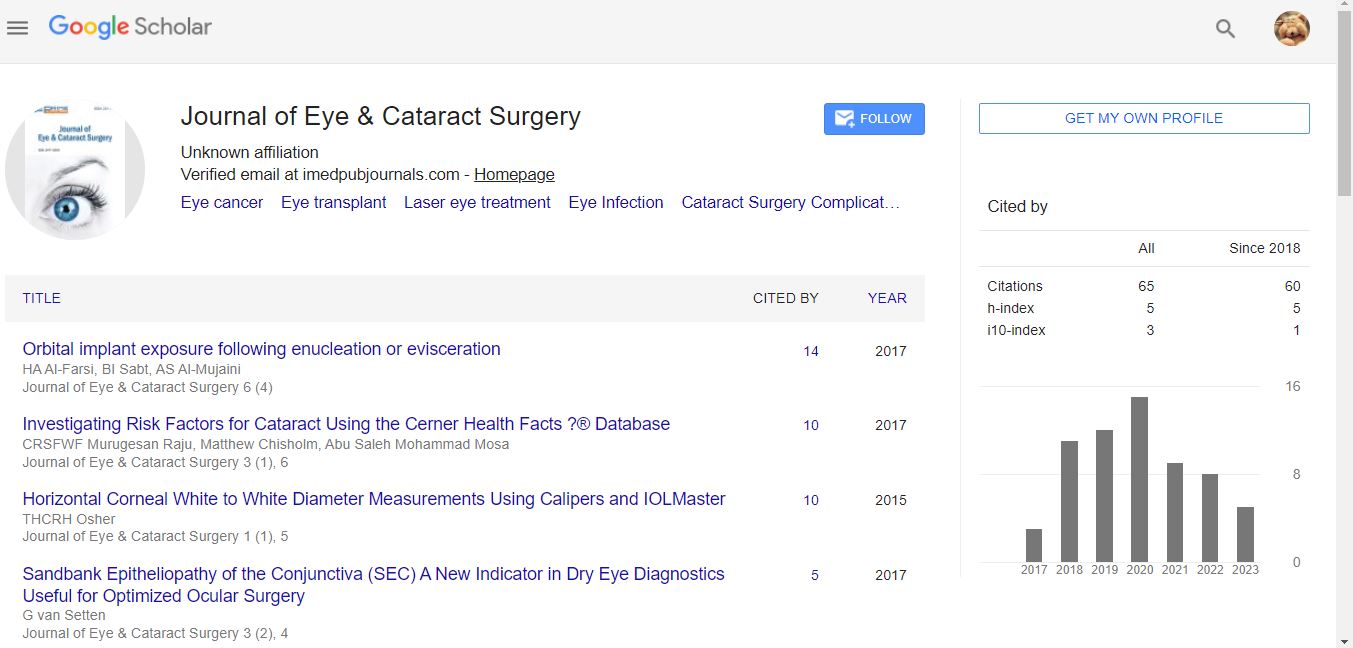Perspective - (2024) Volume 10, Issue 3
Understanding the Role and Mechanisms of Anaesthetic Eye Drops
Lawson Tara*
Department of Ophthalmology, University of Medicine and Health Sciences, USA
*Correspondence:
Lawson Tara,
Department of Ophthalmology, University of Medicine and Health Sciences,
USA,
Email:
Received: 02-Sep-2024, Manuscript No. IPJECS-24-21690;
Editor assigned: 04-Sep-2024, Pre QC No. IPJECS-24-21690 (PQ);
Reviewed: 18-Sep-2024, QC No. IPJECS-24-21690;
Revised: 23-Sep-2024, Manuscript No. IPJECS-24-21690 (R);
Published:
30-Sep-2024, DOI: 10.36648/2471-8300.10.3.30
Introduction
Anaesthetic eye drops play a crucial role in contemporary
ophthalmic practice, enhancing patient comfort during various
eye examinations and surgical procedures. The use of local
anaesthesia in ophthalmology has evolved significantly, allowing
for a wide range of applications, from routine diagnostic tests to
complex surgeries. These eye drops typically contain agents such
as proparacaine, tetracaine, and lidocaine, which temporarily
block nerve conduction in the cornea and conjunctiva. This
mechanism is vital for reducing discomfort, anxiety, and the
blink reflex, enabling both patients and healthcare professionals
to achieve optimal outcomes. Proparacaine is one of the most
commonly used topical anaesthetics in ophthalmology. This
rapid onset is particularly advantageous during procedures such
as tonometry, where intraocular pressure measurements can
cause discomfort. The convenience of proparacaine lies in its
ease of use, as it can be self-administered by the patient under
the guidance of a healthcare provider.
Description
However, it is essential to note that proparacaine can also cause
transient stinging upon instillation, which, although brief, may
be unsettling for some patients. Another commonly utilized
agent, tetracaine, provides a longer duration of anaesthesia
compared to proparacaine. While tetracaine is effective, it is
also associated with a higher incidence of corneal toxicity and
irritation. Clinicians must balance the benefits of pain relief
with the potential risks of complications. It is vital to monitor
patients closely, particularly after procedures that involve
prolonged exposure to anaesthetic agents, to minimize the risk
of corneal damage. The use of anaesthetic eye drops extends
beyond comfort; they also play a significant role in improving
the accuracy of various diagnostic tests. For example, during slitlamp
examinations or fundus photography, the ability to assess
the eye without the interference of discomfort allows for better
visualization and evaluation of ocular structures. Furthermore,
when performing procedures such as cataract surgery or laser
treatments, the administration of anaesthetic eye drops can
facilitate smoother interventions, leading to reduced stress for
both the patient and the surgeon. Despite the advantages, the
use of anaesthetic eye drops is not without limitations. Overuse
or misuse of these agents can lead to complications such as
corneal epithelial toxicity, delayed wound healing, and allergic
reactions. Healthcare professionals must educate patients
on the proper use of these medications and ensure that they
understand the importance of adhering to prescribed guidelines.
In addition, some patients may exhibit sensitivity to specific
anaesthetic agents, necessitating alternative approaches or
additional monitoring. The development of new formulations
and delivery systems is also an ongoing area of research within
the field. Innovations such as sustained-release systems and
preservative-free formulations aim to enhance patient comfort
and reduce the risk of adverse effects.
Conclusion
These advancements could significantly impact the future of
ocular anaesthesia, providing even greater benefits to patients
undergoing ophthalmic procedures. In conclusion, anaesthetic
eye drops are indispensable tools in ophthalmology, significantly
enhancing the patient experience during diagnostic and
therapeutic interventions. By understanding the mechanisms,
applications, and potential risks associated with these agents,
healthcare providers can optimize their use to ensure effective
pain management while minimizing complications. As research
and technology continue to advance, the future of anaesthetic
eye drops promises to offer even more effective and safer
options for patients, further improving outcomes in ocular
health and comfort.
Citation: Tara L (2024) Understanding the Role and Mechanisms of Anaesthetic Eye Drops. J Eye Cataract Surg. 10:30.
Copyright: © 2024 Tara L. This is an open-access article distributed under the terms of the Creative Commons Attribution License,
which permits unrestricted use, distribution, and reproduction in any medium, provided the original author and source are
credited.

